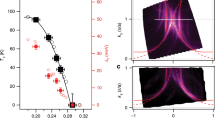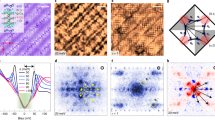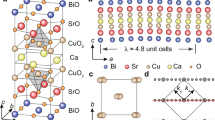Abstract
In conventional superconductors, the phase transition into a zero-resistance and perfectly diamagnetic state is accompanied by a jump in the specific heat and the opening of a spectral gap1. In the high-transition-temperature (high-Tc) cuprates, although the transport, magnetic and thermodynamic signatures of Tc have been known since the 1980s2, the spectroscopic singularity associated with the transition remains unknown. Here we resolve this long-standing puzzle with a high-precision angle-resolved photoemission spectroscopy (ARPES) study on overdoped (Bi,Pb)2Sr2CaCu2O8+δ (Bi2212). We first probe the momentum-resolved electronic specific heat via spectroscopy and reproduce the specific heat peak at Tc, completing the missing link for a holistic description of superconductivity. Then, by studying the full momentum, energy and temperature evolution of the spectra, we reveal that this thermodynamic anomaly arises from the singular growth of in-gap spectral intensity across Tc. Furthermore, we observe that the temperature evolution of in-gap intensity is highly anisotropic in the momentum space, and the gap itself obeys both the d-wave functional form and particle–hole symmetry. These findings support the scenario that the superconducting transition is driven by phase fluctuations. They also serve as an anchor point for understanding the Fermi arc and pseudogap phenomena in underdoped cuprates.
This is a preview of subscription content, access via your institution
Access options
Access Nature and 54 other Nature Portfolio journals
Get Nature+, our best-value online-access subscription
$29.99 / 30 days
cancel any time
Subscribe to this journal
Receive 51 print issues and online access
$199.00 per year
only $3.90 per issue
Buy this article
- Purchase on Springer Link
- Instant access to full article PDF
Prices may be subject to local taxes which are calculated during checkout




Similar content being viewed by others
Data availability
The raw data were generated at beamline 5-4 of the Stanford Synchrotron Radiation Lightsource and the Shen laboratory at Stanford University. The derived data supporting the findings of this study are available within the article and the Extended Data. Source data are provided with this paper.
References
Tinkham, M. Introduction to Superconductivity (Dover, 2004).
Schrieffer, J. R. & Brooks, J. S. Handbook of High-Temperature Superconductivity: Theory and Experiment (Springer, 2007).
Damascelli, A., Hussain, Z. & Shen, Z.-X. Angle-resolved photoemission studies of the cuprate superconductors. Rev. Mod. Phys. 75, 473–541 (2003).
Kondo, T. et al. Disentangling Cooper-pair formation above the transition temperature from the pseudogap state in the cuprates. Nat. Phys. 7, 21–25 (2011).
Reber, T. J. et al. The origin and non-quasiparticle nature of Fermi arcs in Bi2Sr2CaCu2O8+δ. Nat. Phys. 8, 606–610 (2012).
Kondo, T. et al. Point nodes persisting far beyond Tc in Bi2212. Nat. Commun. 6, 7699 (2015).
Zaki, N. et al. Cuprate phase diagram and the influence of nanoscale inhomogeneities. Phys. Rev. B 96, 195163 (2017).
Chen, S.-D. et al. Incoherent strange metal sharply bounded by a critical doping in Bi2212. Science 366, 1099–1102 (2019).
He, Y. et al. Superconducting fluctuations in overdoped Bi2Sr2CaCu2O8+δ. Phys. Rev. X 11, 031068 (2021).
Hashimoto, M. et al. Direct spectroscopic evidence for phase competition between the pseudogap and superconductivity in Bi2Sr2CaCu2O8+δ. Nat. Mater. 14, 37–42 (2014).
Reber, T. J. et al. Pairing, pair-breaking, and their roles in setting the Tc of cuprate high temperature superconductors. Preprint at https://arxiv.org/abs/1508.06252 (2015).
Gomes, K. K. et al. Visualizing pair formation on the atomic scale in the high-Tc superconductor Bi2Sr2CaCu2O8+δ. Nature 447, 569–572 (2007).
Timusk, T. & Statt, B. The pseudogap in high-temperature superconductors: an experimental survey. Reports Prog. Phys. 62, 61–122 (1999).
Loram, J. W., Luo, J., Cooper, J. R., Liang, W. Y. & Tallon, J. L. Evidence on the pseudogap and condensate from the electronic specific heat. J. Phys. Chem. Solids 62, 59–64 (2001).
Tallon, J. L., Storey, J. G., Cooper, J. R. & Loram, J. W. Locating the pseudogap closing point in cuprate superconductors: absence of entrant or reentrant behavior. Phys. Rev. B 101, 174512 (2020).
Keimer, B., Kivelson, S. A., Norman, M. R., Uchida, S. & Zaanen, J. From quantum matter to high-temperature superconductivity in copper oxides. Nature 518, 179–186 (2015).
Mannella, N. et al. Correction of non-linearity effects in detectors for electron spectroscopy. J. Electron Spectros. 141, 45–59 (2004).
Reber, T. J., Plumb, N. C., Waugh, J. A. & Dessau, D. S. Effects, determination, and correction of count rate nonlinearity in multi-channel analog electron detectors. Rev. Sci. Instrum. 85, 043907 (2014).
Kondo, T. et al. Formation of gapless Fermi arcs and fingerprints of order in the pseudogap state of cuprate superconductors. Phys. Rev. Lett. 111, 157003 (2013).
Norman, M. R., Randeria, M., Jankó, B. & Campuzano, J. C. Condensation energy and spectral functions in high-temperature superconductors. Phys. Rev. B 61, 14742 (2000).
Cuk, T. et al. Coupling of the B1g phonon to the antinodal electronic states of Bi2Sr2Ca0.92Y0.08Cu2O8+δ. Phys. Rev. Lett. 93, 117003 (2004).
Sobota, J. A., He, Y. & Shen, Z.-X. Angle-resolved photoemission studies of quantum materials. Rev. Mod. Phys. 93, 025006 (2021).
Emery, V. J. & Kivelson, S. A. Importance of phase fluctuations in superconductors with small superfluid density. Nature 374, 434–437 (1995).
Wang, Y. et al. Field-enhanced diamagnetism in the pseudogap state of the cuprate Bi2Sr2CaCu2O8+δ superconductor in an intense magnetic field. Phys. Rev. Lett. 95, 247002 (2005).
Li, L. et al. Diamagnetism and Cooper pairing above Tc in cuprates. Phys. Rev. B 81, 054510 (2010).
Uemura, Y. J. et al. Magnetic-field penetration depth in TI2Ba2CuO6+δ in the overdoped regime. Nature 364, 605–607 (1993).
Božović, I., He, X., Wu, J. & Bollinger, A. T. Dependence of the critical temperature in overdoped copper oxides on superfluid density. Nature 536, 309–311 (2016).
Eckl, T., Scalapino, D. J., Arrigoni, E. & Hanke, W. Pair phase fluctuations and the pseudogap. Phys. Rev. B 66, 140510 (2002).
Franz, M. & Millis, A. J. Phase fluctuations and spectral properties of underdoped cuprates. Phys. Rev. B 58, 14572–14580 (1998).
Berg, E. & Altman, E. Evolution of the Fermi surface of d-wave superconductors in the presence of thermal phase fluctuations. Phys. Rev. Lett. 99, 247001 (2007).
Lee-Hone, N. R., Dodge, J. S. & Broun, D. M. Disorder and superfluid density in overdoped cuprate superconductors. Phys. Rev. B 96, 024501 (2017).
Li, Z.-X., Kivelson, S. A. & Lee, D.-H. Superconductor-to-metal transition in overdoped cuprates. npj Quantum Mater. 6, 36 (2021).
Kosterlitz, J. M. & Thouless, D. J. Ordering, metastability and phase transitions in two-dimensional systems. J. Phys. C 6, 1181–1203 (1973).
Janke, W. & Matsui, T. Crossover in the XY model from three to two dimensions. Phys. Rev. B 42, 10673–10681 (1990).
Presland, M. R., Tallon, J. L., Buckley, R. G., Liu, R. S. & Flower, N. E. General trends in oxygen stoichiometry effects on Tc in Bi and Tl superconductors. Physica C 176, 95–105 (1991).
Chen, S.-D. High-Precision Photoemission Study of Overdoped Bi2212 Superconductors. PhD thesis, Stanford Univ. (2021).
Acknowledgements
We thank S. A. Kivelson, M. Sulangi, J. L. Tallon, and F. Wang for discussions, and J. L. Tallon for sharing the specific heat data. We thank J.-J. Wen, W. He, and Y. S. Lee for help with magnetic susceptibility measurements. Synchrotron ARPES measurements were performed at Beamline 5-4, Stanford Synchrotron Radiation Lightsource, SLAC National Accelerator Laboratory. The works at Stanford University and SLAC are supported by the US Department of Energy, Office of Science, Office of Basic Energy Sciences, Division of Materials Sciences and Engineering, under contract no. DE-AC02-76SF00515. The works at UC Berkeley and LBNL are supported by the US Department of Energy, Office of Science, Office of Basic Energy Sciences, Materials Sciences and Engineering Division under contract no. DE-AC02-05-CH11231 within the Quantum Materials Program (KC2202).
Author information
Authors and Affiliations
Contributions
S.-D.C., M.H. and Y.-F.L. performed the ARPES experiments. M.H., D.-H. Lu, S.-D.C., Y.H., J.-F.H. and Y.-F.L. contributed to instrument development. D.S., S.I., H.E. and S.-D.C. prepared and characterized the samples. S.-D.C. analysed the data with input from T.P.D., J.Z., D.-H. Lee, and Z.-X.S. S.-D.C., M.H., D.-H. Lee and Z.-X.S. wrote the manuscript with input from all authors. Z.-X.S. supervised the project.
Corresponding author
Ethics declarations
Competing interests
The authors declare no competing interests.
Peer review information
Nature thanks the anonymous reviewers for their contribution to the peer review of this work.
Additional information
Publisher’s note Springer Nature remains neutral with regard to jurisdictional claims in published maps and institutional affiliations.
Extended data figures and tables
Extended Data Fig. 1 Bulk characterization of Tc.
a–e, Real part of the a.c. magnetic susceptibility (χ′) for thin crystals exfoliated from the cleaved surfaces. The sample name and excitation field amplitude are marked in each panel. The field frequency is 4 kHz. f, As in a, for a thick crystal. The grey lines in a–f mark Tc ≈ 77 K.
Extended Data Fig. 2 Consistency of temperature scans.
a–f, Momentum-integrated EDCs from temperature scans. The sample and cut location are marked on top of each panel (see also Extended Data Table 1). The y-axis tick increment is 0.5 for all panels. The curves are offset in steps of 0.5 (a–d) and 1 (e, f) for clarity, and the number beneath each set of curves represents the temperature in K. Each EDC is normalized such that its average intensity equals 1 in the energy window given at the bottom of the corresponding panel. The consistency between curves measured during warming and cooling showcases the stability of the set-up and the absence of sample ageing effects.
Extended Data Fig. 3 Momentum summation.
a, Sθ(T)/Sθ(140 K) plotted as a function of Fermi surface angle θ. We assume that Sθ=0(T) ∝ T. All the other data points are interpolated from the temperature evolutions shown in Fig. 1b. b, Spectral function of the antibonding band integrated along the Brillouin zone boundary. c, Sθ(140 K) as a function of θ. Inset shows the tight-binding Fermi surface in the first quadrant of Brillouin zone. Curves in b and c are calculated using an ARPES-determined tight-binding dispersion with different constant scattering rates. The antinodal scattering rate at 140 K is around 35 meV in our ARPES data. d, Temperature evolution of S calculated using data in a and c. e, Temperature dependence of γ obtained as the derivative of data in d. In d and e, the bulk results are plotted in black for comparison.
Extended Data Fig. 4 Determination of the tight-binding parameters.
a, The dispersion of the antibonding band near the chemical potential (coloured circles) is extracted from ARPES data taken at 250 K on an overdoped Bi2212 sample with a slightly different doping (p ≈ 0.196 from ref. 8). The temperature is chosen such that there are no gaps and more dispersion above the chemical potential can be identified. Data from different momentum cuts (as marked in b) are offset in steps of 0.1 eV for clarity. All data points are fitted at once to the tight-binding expression and the results are plotted as grey crosses. b, Momentum locations of data in a (coloured dots) plotted together with the antibonding Fermi surface (black curves) calculated from the fitting results. The black lines mark the first Brillouin zone. c. As in Fig. 2a, with the tight-binding dispersion plotted in grey. To compensate for the doping difference, we fix t0, t1, and reduce μ by 2.5 meV such that the Van Hove energy from the tight-binding model matches that of the OD77 (p ≈ 0.210) sample studied in the text.
Extended Data Fig. 5 Gap determination.
a–f, kF EDCs divided by the resolution-convolved Fermi function. The corresponding Fermi surface angle is labelled on top of each panel. The EDCs are offset for clarity and the number above each EDC marks the temperature in K. With minimal assumptions, we take the binding energy of the EDC maximum below the chemical potential (vertical blue bars) as the gap size. For the procedure to be robust against noise, we first perform a polynomial fit to each EDC near its maximum (red curves) and then extract the energy position of the maximum from the fitted curve. With increasing temperature, we stop the analysis once the maximum shifts to zero energy.
Extended Data Fig. 6 Anisotropic gap filling and finite energy resolution.
a, b, As in Fig. 3c, d. The Fermi surface angle and the ratio between gap size at 30 K (Δ30K) and energy resolution (Reso) are labelled beneath each curve in a. c, d, As in a, b, but obtained from data intentionally broadened in energy such that all curves have the same Δ30K/Reso of 2.1. The broadening is directly performed on data without Fermi-function division, such as those in Extended Data Fig. 2. The close resemblance between the top and bottom panels indicate that the anisotropic gap filling is not an artefact from finite resolution.
Extended Data Fig. 7 EDC fitting for examining particle–hole symmetry.
a–d, Fermi-function-divided EDCs along the blue curves in Fig. 4c. The cut number is labelled on top of each panel. Curves are offset according to their ky values for clarity. Each EDC is fitted using two Lorentzian peaks with identical width plus a constant background. The results are plotted in red, and the extracted peak positions are marked by the vertical blue bars.
Extended Data Fig. 8 Spectral properties without phase fluctuations.
a, Expected temperature evolution of the superconducting gap for a pure d-wave superconductor in the mean-field theory, where Tc is set by gap opening. b, c, Simulated temperature evolutions of A0 with different scattering rates Γ. The spectral function is calculated as A(k, E) = (1 − α)Γ/{π[(Ε − Ek)2 + Γ2]} + αΓ/{π[(Ε + Ek)2 + Γ2]}, where \({E}_{k}=\sqrt{{\varepsilon }_{k}^{2}+{{\Delta }}_{k}^{2}}\), α = (1 − εk/Ek)/2, and εk is the tight-binding bandstructure. d, As in a, with the gap sizes divided by their corresponding d-wave form factors. e, f, Numerical derivatives of data in b and c, respectively. The vertical grey line in each panel marks Tc. Regardless of the choice of Γ, A0 always stays constant for T > Tc and shows a sharp drop across Tc with decreasing temperature. This singularity also shows up as a jump at Tc in the temperature derivative of A0. As such, the temperature evolutions of Δk, A0 and dA0/dT shown here are qualitatively different from those in Fig. 3.
Source data
Rights and permissions
About this article
Cite this article
Chen, SD., Hashimoto, M., He, Y. et al. Unconventional spectral signature of Tc in a pure d-wave superconductor. Nature 601, 562–567 (2022). https://doi.org/10.1038/s41586-021-04251-2
Received:
Accepted:
Published:
Issue Date:
DOI: https://doi.org/10.1038/s41586-021-04251-2
This article is cited by
-
Absence of a BCS-BEC crossover in the cuprate superconductors
npj Quantum Materials (2023)
Comments
By submitting a comment you agree to abide by our Terms and Community Guidelines. If you find something abusive or that does not comply with our terms or guidelines please flag it as inappropriate.



